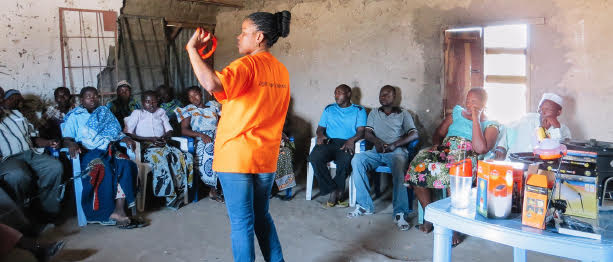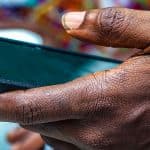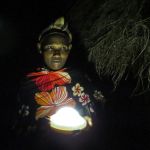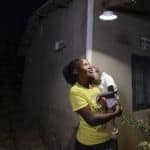More Than Lighting: Women Entrepreneurs Turn Solar Technology Into Opportunity
For the more than 1.2 billion people in the world living without electricity, lighting at night is a huge challenge. Many rural homes rely on kerosene lamps, which cast poor light, can be toxic to their users and, when knocked over, burn some 2.2 million children a year. Among the world’s poorest people, purchasing kerosene can consume up to a third of their total income.
It’s estimated that 95 percent of the world’s people without electricity live in sub-Saharan African or Asian countries. In these areas, solar-powered lanterns offer a promising alternative to kerosene lanterns. Some observers have suggested that the solar-powered lamp will be the technology gadget that “can most quickly improve the lives of the world’s poorest people,” especially since many now incorporate phone-charging features.
In summer 2016, a team from Santa Clara University’s Miller Center for Social Entrepreneurship conducted action research in Tanzania – a country where only 7 percent of the rural population has access to electricity. The Miller Center research team worked in conjunction with Solar Sister, a social enterprise that uses networks of local women to directly sell solar lanterns (and clean cookstoves, which were not included in this Miller Center research project) in remote communities in rural Africa. Solar Sister’s mission is to eradicate energy poverty by empowering women with economic opportunity.
The survey research of more than 250 women in 20 villages found that beyond their ability to provide better lighting, solar-powered lanterns had even more comprehensive and far-reaching effects in the communities where they were used – in areas such as education, health, productivity, finances and women’s economic and social empowerment.
Solar Technology Meets Innovative Business Model
Solar-powered lanterns generate no smoke or noxious fumes, they can’t start fires, they can be touched safely without burning people’s skin, there’s no liquid fuel for children to accidentally ingest, and once purchased they require no ongoing refueling costs.
A good technology solution for a problem such as energy poverty is necessary but not sufficient: the technology still has to get into the hands of the people who need it. For that, a distribution model that meets the needs of the communities affected is an equally powerful innovation.

Photo courtesy of Santa Clara University
Many organizations, including a number of social enterprises, offer solar lanterns to rural households in developing countries as an alternative to kerosene lamps or candles. Solar Sister is one of the most successful of these organizations, at least in part because of its innovative business model.
Solar Sister’s social enterprise business model centers on women-run direct sales networks made up of Solar Sister Entrepreneurs (SSEs, left). Once trained by Solar Sister, the SSEs purchase solar-powered lanterns from the social enterprise and resell them to family, friends and neighbors – thereby building “trust networks.”
According to the Miller Center survey research results, these trust-based social networks are one of the main reasons participants chose to purchase their solar-powered lanterns from Solar Sister.
Solar-Powered Lanterns: More Than Just Lighting
The Miller Center survey found that in addition to lighting homes, solar lanterns are transforming what rural Tanzanians do at home when it’s dark.
Based on the survey findings, here are some of the ways that solar lighting technology is making a difference in the lives of the communities that Solar Sister serves:
- More time for education. In households using solar lanterns, children have more time to study, read and complete homework at night. An overwhelming 90.6 percent of survey respondents reported that their children’s academic performance improved after they started using solar-powered lighting.
- Reduced health risks. More than two-thirds of the Miller Center research survey participants experienced negative health effects such as coughing and cold/flu symptoms while using kerosene lamps. In addition to not causing these health problems, the solar lanterns also prevent the developmental impairment suffered by children exposed to even low levels of kerosene fumes.
- Increased productivity. According to survey respondents, solar lanterns boosted productivity by eliminating travel time required to purchase kerosene, increasing available lighting time after sunset, and allowing people more flexibility to shift the timing of tasks throughout the day. Respondents who increased lighting at night by 1.8 hours daily were able to gain approximately 657 hours, or 27 days, of increased productivity per year. And solar lantern users can now perform activities such as cleaning clothes or preparing school lessons at night, rather than during the busier afternoon hours.
- Larger household incomes. Solar lanterns increased household incomes among Miller Center survey participants in many ways. Families saved money by not having to pay weekly kerosene refueling costs, and they used that money instead to invest in their children’s education or to pay for food and water. Some Solar Sister customers used their savings to join a savings group and take out loans, which gave them more control over their financial decisions. In addition, people had more time to devote to income-generating activities, such as making items to sell (woven baskets, chapatis and other food items, jewelry), farming, taking care of animals and providing services such as sewing or making repairs. And, of course, the SSEs themselves were able to generate incomes to boost their family budgets.
- Economic and social empowerment of women. For some women surveyed, embracing the new solar-powered technology as Solar Sister customers helped raise their status and respect within the community. The Miller Center survey found even greater benefits among Solar Sister Entrepreneurs, who reported greater agency, status and control over their resources than their peers who were customers but not sellers of Solar Sister products. The researchers concluded that being an SSE not only provided direct financial benefits, it also motivated the women to develop new skills, travel and meet new people, engage in leadership roles that broadened their social networks, and helped them become more confident.
Solar-powered lanterns are a great example of how technology, combined with innovative and community-appropriate sales and distribution models, can help address serious issues in the developing world. The Solar Sister results, as captured by the Miller Center survey research team, demonstrate the power of innovation, entrepreneurship and women’s economic empowerment.
Thane Kreiner is the executive director of the Miller Center for Social Entrepreneurship.
Top photo by Tori Yundt, in Uganda.
- Categories
- Energy, Social Enterprise



